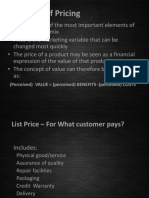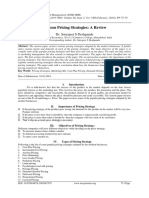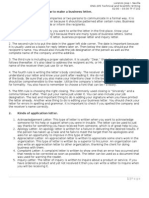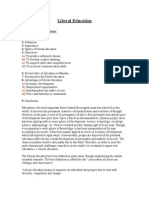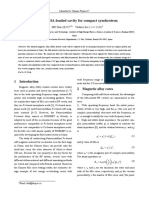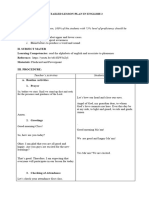Global Pricing Strategy
Global Pricing Strategy
Uploaded by
Ramyata MahajanCopyright:
Available Formats
Global Pricing Strategy
Global Pricing Strategy
Uploaded by
Ramyata MahajanCopyright
Available Formats
Share this document
Did you find this document useful?
Is this content inappropriate?
Copyright:
Available Formats
Global Pricing Strategy
Global Pricing Strategy
Uploaded by
Ramyata MahajanCopyright:
Available Formats
Manish Sharma - 06 MBA-IB 12 Saniya Mahajan - 19 MBA-IB 12
Global Pricing Strategy 1
Pricing is the process of determining what a company will receive in exchange for its products. Pricing factors:
Manufacturing cost Market place Competition Market condition Quality of product
Global Pricing Strategy
Pricing is a fundamental aspect of financial modelling. One of the four Ps of the marketing mix. The other three aspects are Product, Promotion, and Place. Price is the only revenue generating element amongst the four Ps, the rest being cost centres.
Global Pricing Strategy
Global Pricing Strategy
Global Pricing Strategy
Price set to penetrate the market. Low price to secure high volumes. Typical in mass market products chocolate bars, food stuffs, household goods, etc. Suitable for products with long anticipated life cycles. May be useful if launching into a new market.
Global Pricing Strategy
Global Pricing Strategy
High price, Low volumes. Skim the profit from the market. Suitable for products that have short life cycles or which will face competition at some point in the future (e.g. after a patent runs out). Examples include: PlayStation, jewellery, digital technology, new DVDs, etc.
Global Pricing Strategy
Global Pricing Strategy
Price set in accordance with customer perceptions about the value of the product/service. Examples include status products/exclusive products.
Global Pricing Strategy
10
Global Pricing Strategy
11
Goods/Services deliberately sold below cost to encourage sales elsewhere. Typical in supermarkets, e.g. at Christmas, selling bottles of gin at 3 in the hope that people will be attracted to the store and buy other things. Purchases of other items more than covers loss on item sold.
Global Pricing Strategy
12
Global Pricing Strategy
13
Used to play on consumer perceptions. Example - 9.99 instead of 10.99! Links with value pricing high value goods priced according to what consumers think should be the price.
Global Pricing Strategy
14
Global Pricing Strategy
15
In case of price leader, rivals have difficulty in competing on price too high and they lose market share, too low and the price leader would match price and force smaller rival out of market. Where competition is limited, going rate pricing may be applicable banks, petrol, supermarkets, electrical goods find very similar prices in all outlets.
Global Pricing Strategy
16
Global Pricing Strategy
17
Many contracts awarded on a tender basis. Firms submit their price for carrying out the work. Purchaser then chooses which represents best value. Mostly done in secret.
Global Pricing Strategy
18
Global Pricing Strategy
19
Charging a different price for the same good/service in different markets. Requires each market to be impenetrable. Requires different price elasticity of demand in each market.
Global Pricing Strategy
20
Global Pricing Strategy
21
Deliberate price cutting or offer of free gifts/products to force rivals (normally smaller and weaker) out of business or prevent new entrants. Anti-competitive and illegal if it can be proved.
Global Pricing Strategy
22
Global Pricing Strategy
23
Full Cost Pricing Attempting to set price to cover both fixed and variable costs. Absorption Cost Pricing Price set to absorb some of the fixed costs of production.
Global Pricing Strategy
24
Global Pricing Strategy
25
Marginal cost the cost of producing one extra or one fewer item of production. MC pricing allows flexibility. Particularly relevant in transport where fixed costs may be relatively high. Allows variable pricing structure.
Global Pricing Strategy
26
Global Pricing Strategy
27
Contribution = Selling Price Variable (direct costs) Prices set to ensure coverage of variable costs and a contribution to the fixed costs. Similar in principle to marginal cost pricing. Break-even analysis might be useful in such circumstances.
Global Pricing Strategy
28
Global Pricing Strategy
29
Setting price to target a specified profit level. Estimates of the cost and potential revenue at different prices, and thus the break-even have to be made, to determine the mark-up. Mark-up = Profit/Cost x 100
Global Pricing Strategy
30
Global Pricing Strategy
31
Calculation of the Average Cost (AC) plus a mark up. AC = Total Cost/Output
Global Pricing Strategy
32
Global Pricing Strategy
33
Any pricing decision must be mindful of the impact of price elasticity. The degree of price elasticity impacts on the level of sales and hence revenue. Elasticity focuses on proportionate (percentage) changes. PED = % Change in Quantity demanded % Change in Price
Global Pricing Strategy
34
Global Pricing Strategy
35
You might also like
- LWR-Dr. Jose Rizal Timeline (25-35 Years Old)Document7 pagesLWR-Dr. Jose Rizal Timeline (25-35 Years Old)Honey Lance Blanco100% (1)
- Boston Marriage Is A 1999 Play by American Playwright DavidDocument4 pagesBoston Marriage Is A 1999 Play by American Playwright DavidnilNo ratings yet
- NCP Failure To Thrive.Document14 pagesNCP Failure To Thrive.Yashoda Satpute100% (3)
- Languages of The AndesDocument745 pagesLanguages of The AndesFelipe Ascencio100% (1)
- Completions and WorkoverDocument309 pagesCompletions and WorkoverFan Jack67% (3)
- Pricing Strategies PPT at Bec Doms Mba BagalkotDocument48 pagesPricing Strategies PPT at Bec Doms Mba BagalkotBabasab Patil (Karrisatte)No ratings yet
- Pricing StrategyDocument25 pagesPricing StrategyVivek LingwalNo ratings yet
- Pricing PracticesDocument30 pagesPricing PracticessuryaabhimaniNo ratings yet
- Price The 2nd P of Marketing.Document63 pagesPrice The 2nd P of Marketing.vinaycool12344150No ratings yet
- 6 Pricing ApprochesDocument8 pages6 Pricing ApprocheskmvilasNo ratings yet
- CH 6 PricingDocument20 pagesCH 6 PricingkichuubmcNo ratings yet
- Pricing and Pricing StrategiesDocument17 pagesPricing and Pricing Strategiesakash nillNo ratings yet
- Pricing 1Document25 pagesPricing 1Mussadique HussainNo ratings yet
- Marketing Finance OmkarDocument11 pagesMarketing Finance Omkariomkar_osi2415No ratings yet
- Pricing For International MarketingDocument44 pagesPricing For International Marketingjuggy1812No ratings yet
- Bem102 7Document22 pagesBem102 7Mellisa AndileNo ratings yet
- Pricing Decisions - Nov. 2017Document10 pagesPricing Decisions - Nov. 2017vicent laurianNo ratings yet
- Pricing & Channels of DistributionDocument60 pagesPricing & Channels of Distributionsumeet kcNo ratings yet
- Price: AN Important Tool of Marketing MixDocument15 pagesPrice: AN Important Tool of Marketing Mixanupamvidya2108No ratings yet
- PricingDocument28 pagesPricingVishal JesaniNo ratings yet
- Pricing Strategies For The Asia PacificDocument25 pagesPricing Strategies For The Asia Pacificrahmat_dinurNo ratings yet
- Unit 4 Pricing MethodsDocument37 pagesUnit 4 Pricing Methodsvishal chaurasiaNo ratings yet
- Pricing NotesDocument5 pagesPricing NotesDaniel HarrisonNo ratings yet
- CHAPTER 6.1 - Pricing StrategyDocument30 pagesCHAPTER 6.1 - Pricing StrategyKarl Barnuevo0% (1)
- Pricing Strategies For The Asia PacificDocument25 pagesPricing Strategies For The Asia PacificTerry MathewNo ratings yet
- Pricing Strategies For The Asia PacificDocument25 pagesPricing Strategies For The Asia PacificRohit JoshiNo ratings yet
- Week3 Day5Document12 pagesWeek3 Day5Dheeraj Kumar ReddyNo ratings yet
- Pricing StrategyDocument50 pagesPricing StrategyNorita RachmanNo ratings yet
- Pricing Policy NotesDocument67 pagesPricing Policy NotesMellisa AndileNo ratings yet
- International MarketDocument21 pagesInternational MarketNathish RajendranNo ratings yet
- Factors Influencing Pricing Methods and Price and NonDocument17 pagesFactors Influencing Pricing Methods and Price and NonRutujaNo ratings yet
- Lesson Seven - Pricing DecisionDocument7 pagesLesson Seven - Pricing DecisionJacy VykeNo ratings yet
- Economic Analysis Policy - IDocument30 pagesEconomic Analysis Policy - IThaddeus De MenezesNo ratings yet
- W8 1Price-StudentwithNotes (PBN)Document31 pagesW8 1Price-StudentwithNotes (PBN)CharityChanNo ratings yet
- Marketing CH 13 Pricing Concepts For Establishing Value: Study Online atDocument3 pagesMarketing CH 13 Pricing Concepts For Establishing Value: Study Online atConner DowneyNo ratings yet
- Managerial Economics 1st SemDocument39 pagesManagerial Economics 1st SemAmrutha GowdaNo ratings yet
- Pricing StrategiesDocument46 pagesPricing StrategiesJabeer Ibnu Rasheed100% (1)
- Principles of Business Decisions - SEction IDocument4 pagesPrinciples of Business Decisions - SEction ISheethalNo ratings yet
- Ch. 2 PricingDocument10 pagesCh. 2 PricingAshu DrwalNo ratings yet
- International Pricing Strategy For Successful ExpansionDocument5 pagesInternational Pricing Strategy For Successful ExpansionStavroula KalogerasNo ratings yet
- Module-3 Pricing: "Price Is The Amount of Money or Goods For Which A Thing Is Bought or Sold"Document7 pagesModule-3 Pricing: "Price Is The Amount of Money or Goods For Which A Thing Is Bought or Sold"murshidaman3No ratings yet
- Multipoint PricingDocument11 pagesMultipoint PricingAbdullah RasheelNo ratings yet
- Step 4: Export Pricing Strategies at Your DisposalDocument5 pagesStep 4: Export Pricing Strategies at Your DisposalVignesh RavindranNo ratings yet
- Price PolicyDocument9 pagesPrice PolicyGopi ShankarNo ratings yet
- Chapter 6Document5 pagesChapter 6Munirah DIB1B F2008No ratings yet
- What Is Pricing - BbaDocument66 pagesWhat Is Pricing - Bbarastogishreya920No ratings yet
- T5 Price Lecture Slides S3.20Document54 pagesT5 Price Lecture Slides S3.20Khoa Cao100% (1)
- ACBA - Presentation-Pricing StrategyDocument20 pagesACBA - Presentation-Pricing StrategyWazed Arvi KhanNo ratings yet
- CH6 Retail PricingDocument36 pagesCH6 Retail PricingArafat hossainNo ratings yet
- Marketing I CHAPTERS 10, 11 & 12Document8 pagesMarketing I CHAPTERS 10, 11 & 12Alejandra Oliver RodriguezNo ratings yet
- "You Don't Sell Through Price. You Sell The Price" Price Is The Marketing-Mix Element That Produces Revenue The Others Produce CostDocument22 pages"You Don't Sell Through Price. You Sell The Price" Price Is The Marketing-Mix Element That Produces Revenue The Others Produce Cost200eduNo ratings yet
- 10 PriceDocument15 pages10 Pricej8x4sbgdjbNo ratings yet
- Chapter Six Nternational Marketing For Ug StudentsDocument52 pagesChapter Six Nternational Marketing For Ug StudentsEyob ZekariyasNo ratings yet
- Chapter 13 Global Pricing International Marketing 466 Fall 2003Document9 pagesChapter 13 Global Pricing International Marketing 466 Fall 2003tekleyNo ratings yet
- Marketing Management.: Pricing Considerations & StrategiesDocument26 pagesMarketing Management.: Pricing Considerations & StrategiesMrigna GuptaNo ratings yet
- UNIT IVDocument19 pagesUNIT IVprincemaurya2244No ratings yet
- PRICE and PROMOTIONDocument19 pagesPRICE and PROMOTIONArabinda SarangiNo ratings yet
- International Marketing StrategyDocument15 pagesInternational Marketing StrategyDehan Annafi MawansyahNo ratings yet
- Chapter 6. PricingDocument26 pagesChapter 6. PricingTadele BekeleNo ratings yet
- Various Pricing Strategies: A Review: Dr. Satyajeet S DeshpandeDocument5 pagesVarious Pricing Strategies: A Review: Dr. Satyajeet S DeshpandeGis PeeNo ratings yet
- Pricing in MarketingDocument16 pagesPricing in MarketingAditya PrakashNo ratings yet
- Module 8 - PriceDocument21 pagesModule 8 - PriceChristine SeriosaNo ratings yet
- Pricing-Strategies (Pizza Hut)Document21 pagesPricing-Strategies (Pizza Hut)Afrin AhmedNo ratings yet
- Pricing Decision-Student Copy - 2Document17 pagesPricing Decision-Student Copy - 2Syazwan Lagenda Bola SepakNo ratings yet
- Smart Pricing (Review and Analysis of Raju and Zhang's Book)From EverandSmart Pricing (Review and Analysis of Raju and Zhang's Book)Rating: 4 out of 5 stars4/5 (1)
- All About Business Letter Aug 15Document3 pagesAll About Business Letter Aug 15Enzo IgnacioNo ratings yet
- Petri Nets - ApplicationsDocument762 pagesPetri Nets - ApplicationscemokszNo ratings yet
- Asia Pacific and South Asia and The WorldDocument8 pagesAsia Pacific and South Asia and The Worldsaythename.smmaNo ratings yet
- Funksionet e PerberaDocument4 pagesFunksionet e PerberaunazaNo ratings yet
- 1Z0-071 Sample QuestionsDocument8 pages1Z0-071 Sample QuestionsmadhubanNo ratings yet
- Sales SupportDocument140 pagesSales SupportResylyn CabreraNo ratings yet
- Our Lady of Lebanon - TorontoDocument3 pagesOur Lady of Lebanon - TorontoMaronite ParishNo ratings yet
- M1 Dynamics - Connected ParticlesDocument32 pagesM1 Dynamics - Connected ParticlesDarla FennNo ratings yet
- Impact of Indian Cinema On AdolescentsDocument14 pagesImpact of Indian Cinema On AdolescentsSunil Kumar P GNo ratings yet
- Group 4 - A Reading Buddy Written ReportDocument4 pagesGroup 4 - A Reading Buddy Written ReportRustom RizoNo ratings yet
- Schools of PsychologyDocument16 pagesSchools of PsychologyRicha MalhotraNo ratings yet
- Notice Reply of Pawan Bothra (Final)Document4 pagesNotice Reply of Pawan Bothra (Final)Rittik SarkarNo ratings yet
- Liberal EducationDocument5 pagesLiberal EducationArshad HussainNo ratings yet
- United States Court of Appeals, Fourth CircuitDocument12 pagesUnited States Court of Appeals, Fourth CircuitScribd Government DocsNo ratings yet
- Drashti CertificateDocument8 pagesDrashti CertificateBhavin DabhiNo ratings yet
- Ride InfoDocument33 pagesRide InfoSwati AthavaleNo ratings yet
- Worksheets-and-Handouts OvercomingParentalAnxietyDocument16 pagesWorksheets-and-Handouts OvercomingParentalAnxietyLeandro BarrosNo ratings yet
- RES 351 Genius Education ExpertDocument34 pagesRES 351 Genius Education ExpertcritterNo ratings yet
- Necrosis and Types of NecrosisDocument2 pagesNecrosis and Types of NecrosisHisham NesemNo ratings yet
- Factor Analysis: (Dataset1)Document5 pagesFactor Analysis: (Dataset1)trisnokompNo ratings yet
- Chapter 24 Last Home Coming and TrialDocument17 pagesChapter 24 Last Home Coming and Trialwinnots95% (22)
- 1504 02257Document5 pages1504 02257bhai jaanNo ratings yet
- The Fundamental Freedom To Trade by Edward L. HudginsDocument9 pagesThe Fundamental Freedom To Trade by Edward L. HudginsmirunelutuNo ratings yet
- Chapter 13Document55 pagesChapter 13g-08221486No ratings yet
- DLP in EnglishDocument6 pagesDLP in EnglishRossalie Valdez RelojasNo ratings yet





















